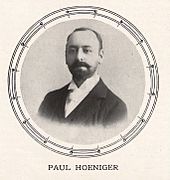Paul Hoeniger
Paul Hoeniger (also: Paul Höniger ; born March 9, 1865 in Berlin ; † April 24, 1924 in Berlin) was a German painter of the Wilhelmine era .
Live and act
education
Paul Hoeniger studied at the art academies in Berlin and Munich . He was a famous student of the painter Franz Skarbina in Berlin at the time. In 1891 he traveled to Paris to study contemporary impressionist painters and enrolled at the Académie Julian . He was mainly influenced by the work of Camille Pissarro , but also by the depictions of the " Belle Epoque " by Jean Béraud .
Study trips
From Paris, Paul Hoeniger also undertook various study trips to other cities, including Belgium and the Netherlands , where he studied the works of deceased and current artists located there, following the example of similar trips by his teacher Franz Skarbina.
Painter of everyday scenes
After his return to Germany he lived at Königin-Augusta-Strasse 41 in Berlin, in the same house as his teacher Franz Skarbina. As he had learned to do in Paris, he mainly painted everyday scenes and became known as a specialist in this genre. Gerhard Strauss even describes him as "a forgotten painter of Berlin and its working class". Some of Hoeniger's early drawings, e. B. the graphics early morning for work , Berliner Dienstmann , Berlin O. and In der Garnfärberei can support this judgment. With his choice of subjects, Paul Hoeniger clearly stands out from other painters of the epoch, who preferred historical-heroic or military-political subjects and were thus able to secure the attention and approval of official bodies.
Exhibition activity
From 1888 he took part in the exhibitions of the Berlin Academy of the Arts, where his picture in the Café Josty attracted attention, as well as in the Great Berlin Art Exhibition . At the first exhibition of the Berlin Secession in 1899 he showed his painting Alt-Berlin .
At the second exhibition of the Berlin Secession in 1900, he showed the oil painting An old angle and stop (foggy mood) . From 1900 Hoeniger was listed as a full member of the Berlin Secession. Between 1891 and 1912 he participated regularly in exhibitions in Germany ( Munich Glass Palace ), but also took part in exhibitions in Paris, including the salon exhibitions of 1895, 1898 and 1904.
Paul Hoeniger died in Berlin in 1924.
Works (selection)
|
|
gallery
literature
- Hoeniger, Paul . In: Hans Vollmer (Hrsg.): General lexicon of fine artists from antiquity to the present . Founded by Ulrich Thieme and Felix Becker . tape 17 : Heubel – Hubard . EA Seemann, Leipzig 1924, p. 210-211 .
Web links
Individual evidence
- ↑ Hoeniger, Paul . In: Hans Vollmer (Hrsg.): General Lexicon of Fine Artists of the XX. Century. tape 6 , supplements H-Z . EA Seemann, Leipzig 1962, p. 65 .
- ↑ Paul Hoeniger †. In: Vossische Zeitung. April 25, 1924, evening edition (bottom left column; staatsbibliothek-berlin.de ).
- ^ Berlin life. Heft 3, 1901, p. 50. Paul Höniger is referred to as a “famous” Skarbina student there ( digital.zlb.de ).
- ^ Anonymus: Berlin and the Berliners. J. Bielefelds Verlag, Karlsruhe 1905, p. 96 ( Textarchiv - Internet Archive ).
- ^ Gerhard Strauss: Paul Hoeniger. Fine arts magazine . 30, 1982, pp. 86-88.
- ^ Catalog of the German art exhibition of the "Berlin Secession". Cassirer, Berlin 1899, p. 24 ( Textarchiv - Internet Archive ).
- ^ Catalog of the second art exhibition of the Berlin Secession. Cassirer, Berlin 1900, p. 26 ( Textarchiv - Internet Archive ).
| personal data | |
|---|---|
| SURNAME | Hoeniger, Paul |
| ALTERNATIVE NAMES | Höniger, Paul |
| BRIEF DESCRIPTION | German painter |
| DATE OF BIRTH | March 9, 1865 |
| PLACE OF BIRTH | Berlin |
| DATE OF DEATH | April 24, 1924 |
| Place of death | Berlin |









